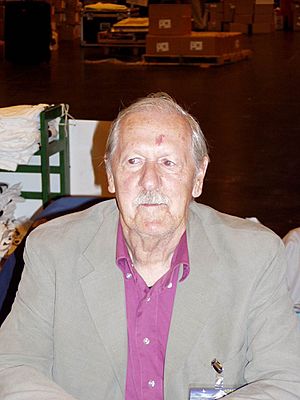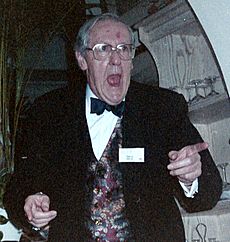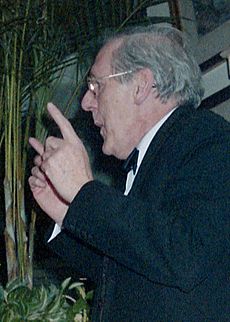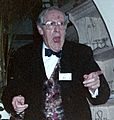Brian Aldiss facts for kids
Quick facts for kids
Brian Aldiss
|
|
|---|---|

Aldiss at Interaction in Glasgow, 2005
|
|
| Born | Brian Wilson Aldiss 18 August 1925 East Dereham, Norfolk, England |
| Died | 19 August 2017 (aged 92) Oxford, England |
| Pen name |
|
| Occupation |
|
| Period | 1954–2017 |
| Genre | Science fiction |
| Notable works |
|
Brian Wilson Aldiss (born August 18, 1925 – died August 19, 2017) was an English writer, artist, and editor. He was most famous for his science fiction novels and short stories. Sometimes he used different names, but mostly he was known as Brian W. Aldiss or Brian Aldiss.
Brian Aldiss was greatly inspired by H. G. Wells, a famous science fiction writer. Aldiss became a vice-president of a group honoring Wells. He also led the Birmingham Science Fiction Group with Harry Harrison. Aldiss won many important awards, including the Hugo Award twice and the Nebula Award once. He was named a Grand Master by the Science Fiction Writers of America in 1999. He was also added to the Science Fiction Hall of Fame in 2004. One of his short stories, "Supertoys Last All Summer Long" (1969), was used to create the Steven Spielberg film A.I. Artificial Intelligence (2001). Aldiss was a key part of the "British New Wave" in science fiction, which brought new ideas to the genre.
Contents
Life and Career
Early Life and Military Service
Brian Wilson Aldiss was born on August 18, 1925, in Dereham, England. His family later moved from Dereham. As a young child, around three years old, Brian started writing stories. His mother would even bind them into little books for him.
When he was six, he went to Framlingham College. Later, in 1939, he moved to Devon and attended West Buckland School. During his childhood, he discovered Astounding Science Fiction magazine. He read all the books by H. G. Wells and Robert Heinlein. In 1943, during World War II, he joined the Royal Signals and served in Burma.
Becoming a Writer
His time in the army gave him ideas for some of his books. After the war, he worked in a bookshop in Oxford. He wrote short pieces about life in a made-up bookshop for a trade magazine. These writings caught the eye of an editor at Faber and Faber, a publishing company.
This led to Faber and Faber publishing his first book, The Brightfount Diaries (1955). It was a novel written like a diary about a bookshop assistant. Around the same time, he started writing science fiction for different magazines. His first science fiction story, Criminal Record, came out in July 1954.
In 1954, The Observer newspaper held a short story competition. Brian's story, Not For An Age, came in third place. Because The Brightfount Diaries was a small success, Faber asked him for more writing. He told them he wrote science fiction, and they were happy about it. So, his first science fiction book, Space, Time and Nathaniel (1957), was published. Soon, he was earning enough from writing to become a full-time author.
In 1960, Aldiss became the president of the British Science Fiction Association. He also worked as the literary editor for the Oxford Mail newspaper from 1958 to 1969. Around 1964, he and his friend Harry Harrison started a magazine called Science Fiction Horizons. It was one of the first magazines to review and discuss science fiction.
Aldiss also edited many collections of stories by other writers. For example, he edited Introducing SF and Best Fantasy Stories. He also put together popular collections of science fiction stories for Penguin Books. These were called Penguin Science Fiction, More Penguin Science Fiction, and Yet More Penguin Science Fiction. They were so successful that they were later combined into The Penguin Science Fiction Omnibus.
He also created a very short story style called the mini-saga. The Daily Telegraph newspaper held a competition for the best mini-saga for many years, and Aldiss was the judge.
Artistic Endeavors
Besides being a successful writer, Brian Aldiss was also a talented artist. His first art show, called The Other Hemisphere, was held in Oxford in 2010. The main artwork, Metropolis, was later made into a special print. The show's title meant that his words from one side of his brain inspired images in the "other hemisphere" of his mind.
Personal Life and Death
In 1948, Aldiss married Olive Fortescue. They had two children, Clive and Caroline Wendy. Their marriage ended in 1965. In the same year, he married Margaret Christie Manson. They lived in Oxford and had two children, Tim and Charlotte. Margaret passed away in 1997.
Brian Aldiss died on August 19, 2017, just one day after his 92nd birthday.
Awards and Honors
Brian Aldiss received many awards and honors for his writing.
- In 1990, he was chosen as a Fellow of the Royal Society of Literature.
- He was a special guest at the International Conference on the Fantastic in the Arts for many years.
- The Science Fiction Writers of America named him their 18th SFWA Grand Master in 1999.
- He was inducted into the Science Fiction and Fantasy Hall of Fame in 2004.
- In 2005, he was awarded the title of Officer of the Order of the British Empire (OBE) for his contributions to literature.
- In 2008, the University of Liverpool gave him an honorary doctorate for his literary work.
- He won two Hugo Awards: one in 1962 for his Hothouse series and another in 1987 for Trillion Year Spree.
- He also won a Nebula Award in 1965 for his story "The Saliva Tree".
- In 2013, he received the World Fantasy Convention Award.
Notable Works
Brian Aldiss wrote over 80 books and 300 short stories. He also published several poetry collections.
Novels
Here are some of his well-known novels:
- Non-Stop (1958): This story is about people living on a huge generation ship. Over many generations, they have forgotten they are on a ship. A character explores the ship and slowly learns the truth about their world.
- Hothouse (1962): Set in a very distant future, the Earth has stopped spinning, and the Sun is much hotter. Plants grow incredibly fast, like a super-tropical forest. A few small groups of humans try to survive under a giant banyan tree that covers one side of the Earth. This book won a Hugo Award.
- Greybeard (1964): This novel takes place decades after a global event that made people unable to have children. The world is slowly emptying as the population grows older with no new births.
- The Malacia Tapestry (1976): This is a fantasy novel set in a city that feels like an alternate version of Venice during the Renaissance. It's a world where magic is real, and different ideas about reality exist.
- Helliconia Trilogy (1982-1985): This is a series of three books: Helliconia Spring, Helliconia Summer, and Helliconia Winter. They tell the story of a planet called Helliconia, which has a very long year because it orbits two suns. This causes extreme seasons that greatly affect life on the planet. The first book won the BSFA Award and the John W. Campbell Memorial Award.
- Frankenstein Unbound (1973): In this story, a politician from the 21st century is sent back in time to 19th-century Switzerland. There, he meets Victor Frankenstein, his Monster, and Mary Shelley.
Short Stories
Aldiss wrote many short stories. One of his most famous is "Supertoys Last All Summer Long" (1969). This story was the inspiration for the movie A.I. Artificial Intelligence.
Some of his short story collections include:
- Space, Time and Nathaniel (1957)
- The Canopy of Time (1959)
- The Saliva Tree and Other Strange Growths (1966): The main story, "The Saliva Tree," won the Nebula Award for best novella in 1964.
- The Moment of Eclipse (1970): This collection won the British Science Fiction Association (BSFA) Award.
Adaptations
Several of Brian Aldiss's works have been turned into films:
- Frankenstein Unbound (1990): A film directed by Roger Corman, based on Aldiss's novel of the same name.
- A.I. Artificial Intelligence (2001): A film directed by Steven Spielberg, based on Aldiss's short story "Supertoys Last All Summer Long".
- Brothers of the Head (2005): A film based on his novel about conjoined twins who become rock stars.
Images for kids
See also
 In Spanish: Brian W. Aldiss para niños
In Spanish: Brian W. Aldiss para niños








